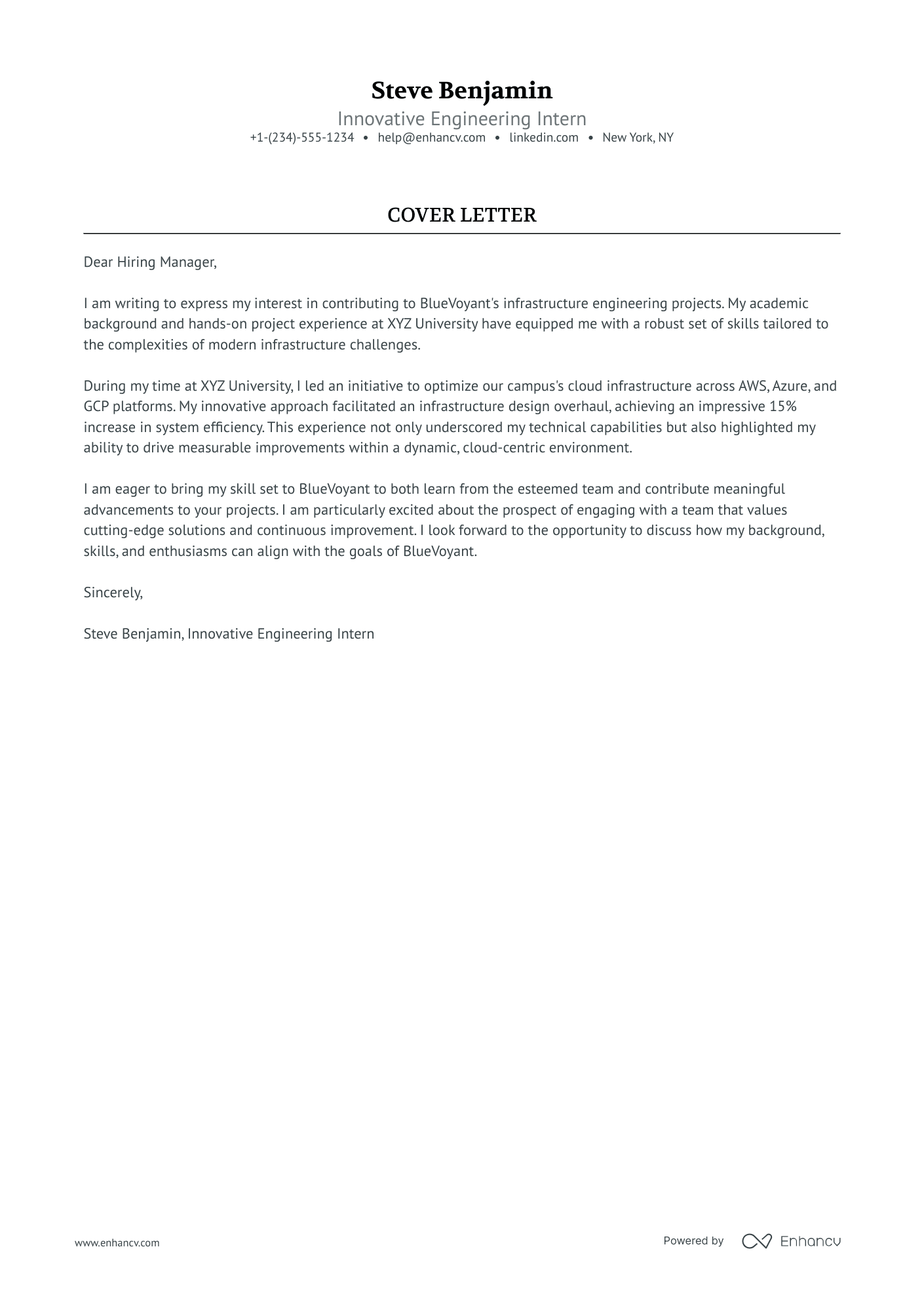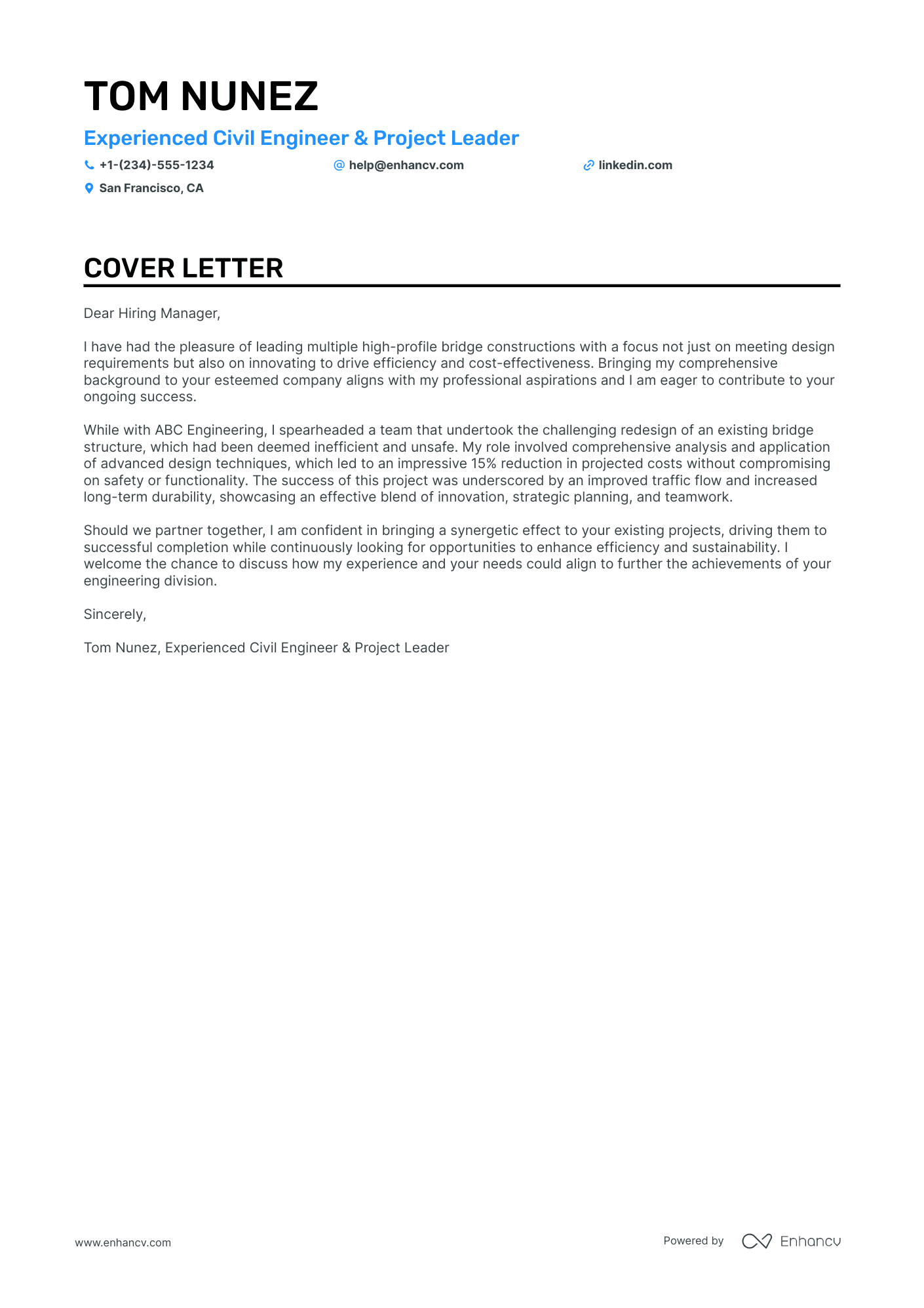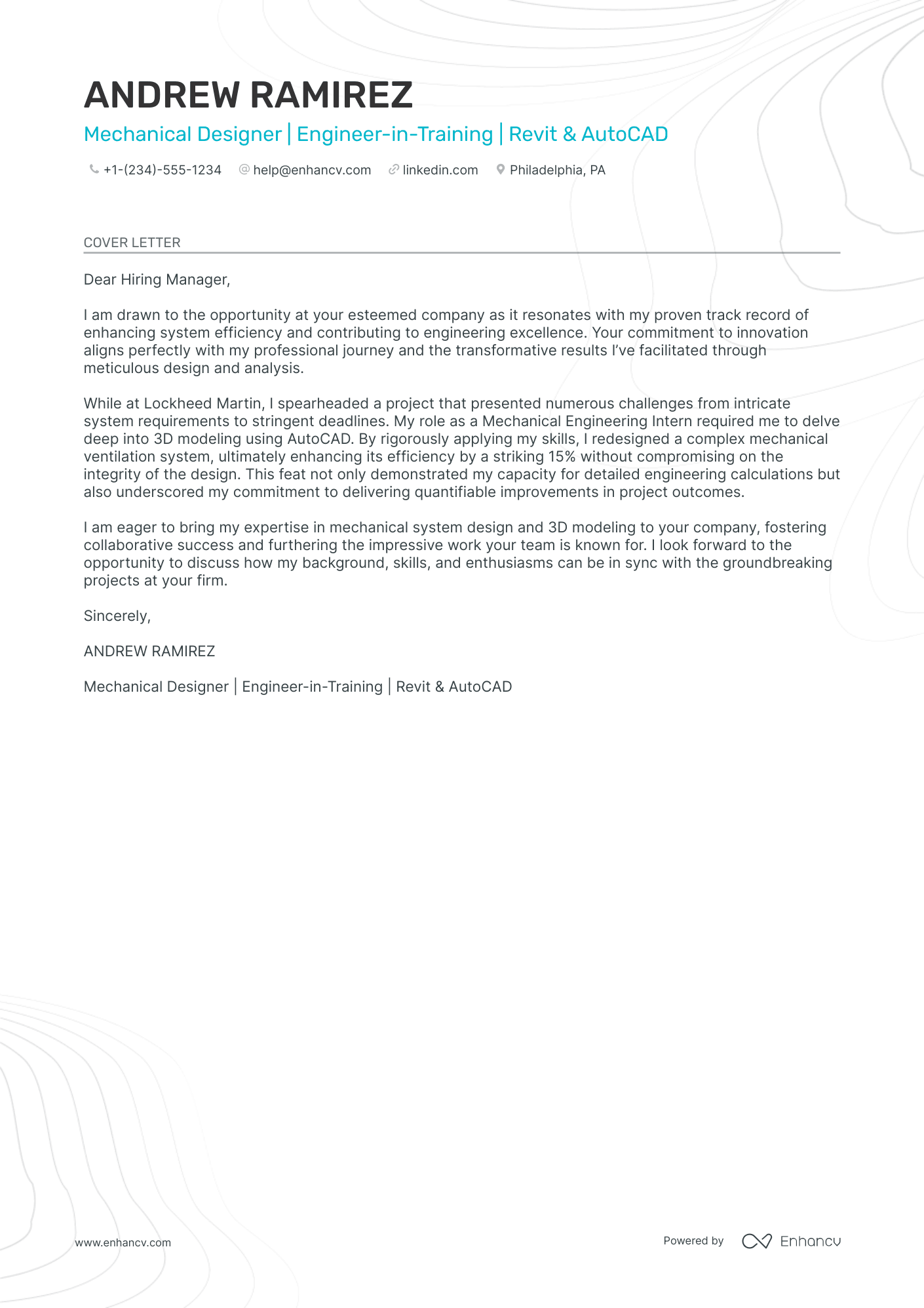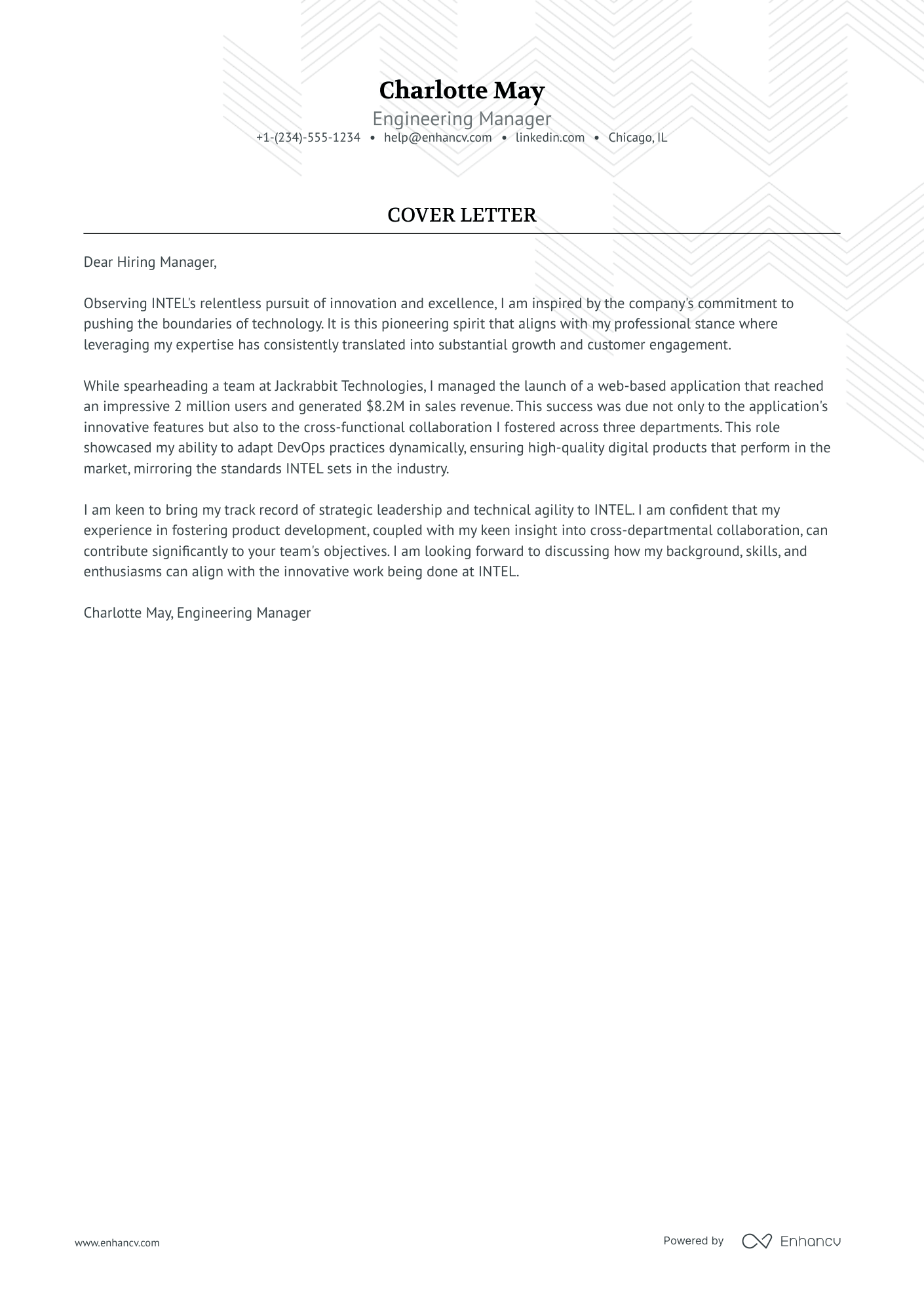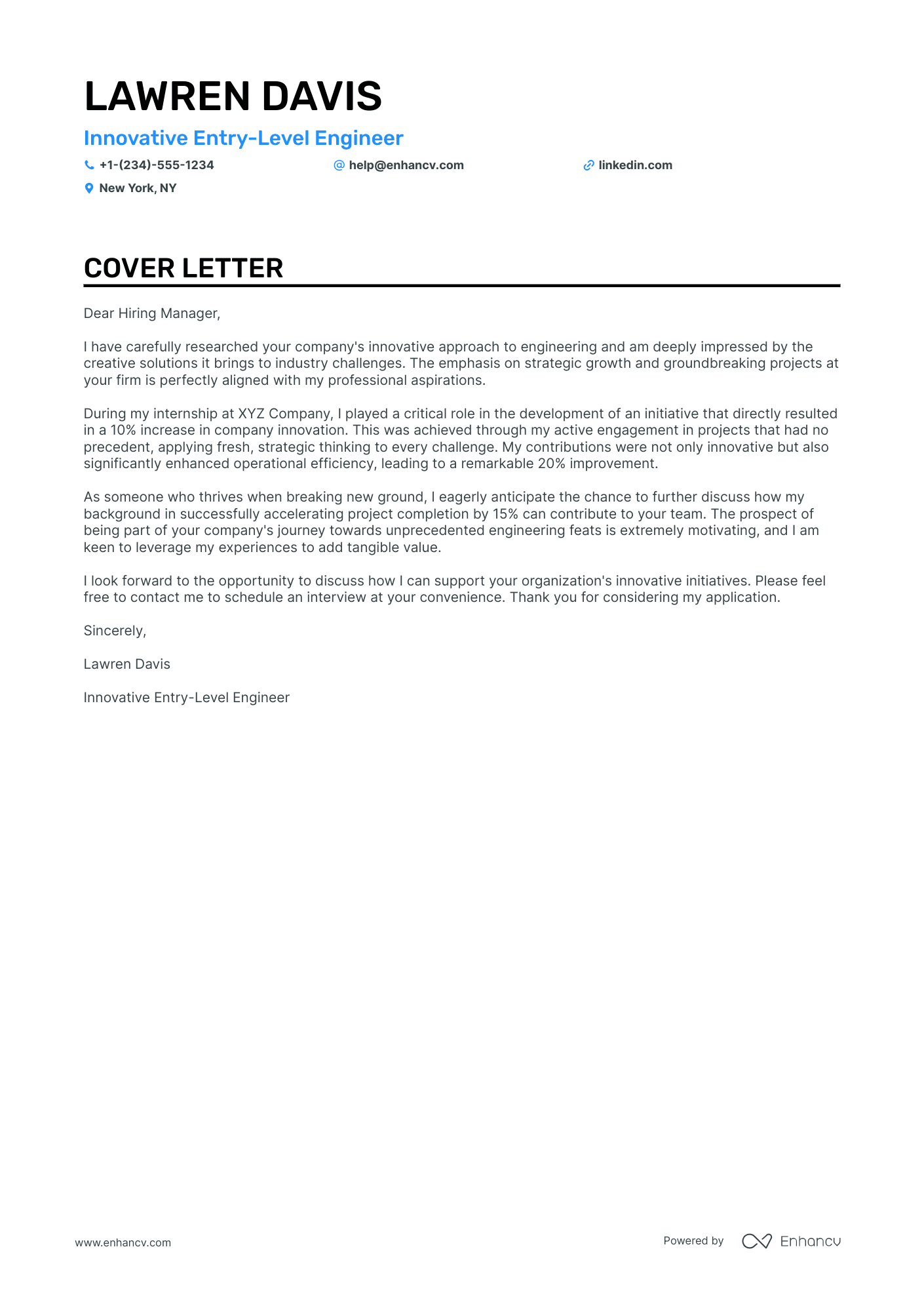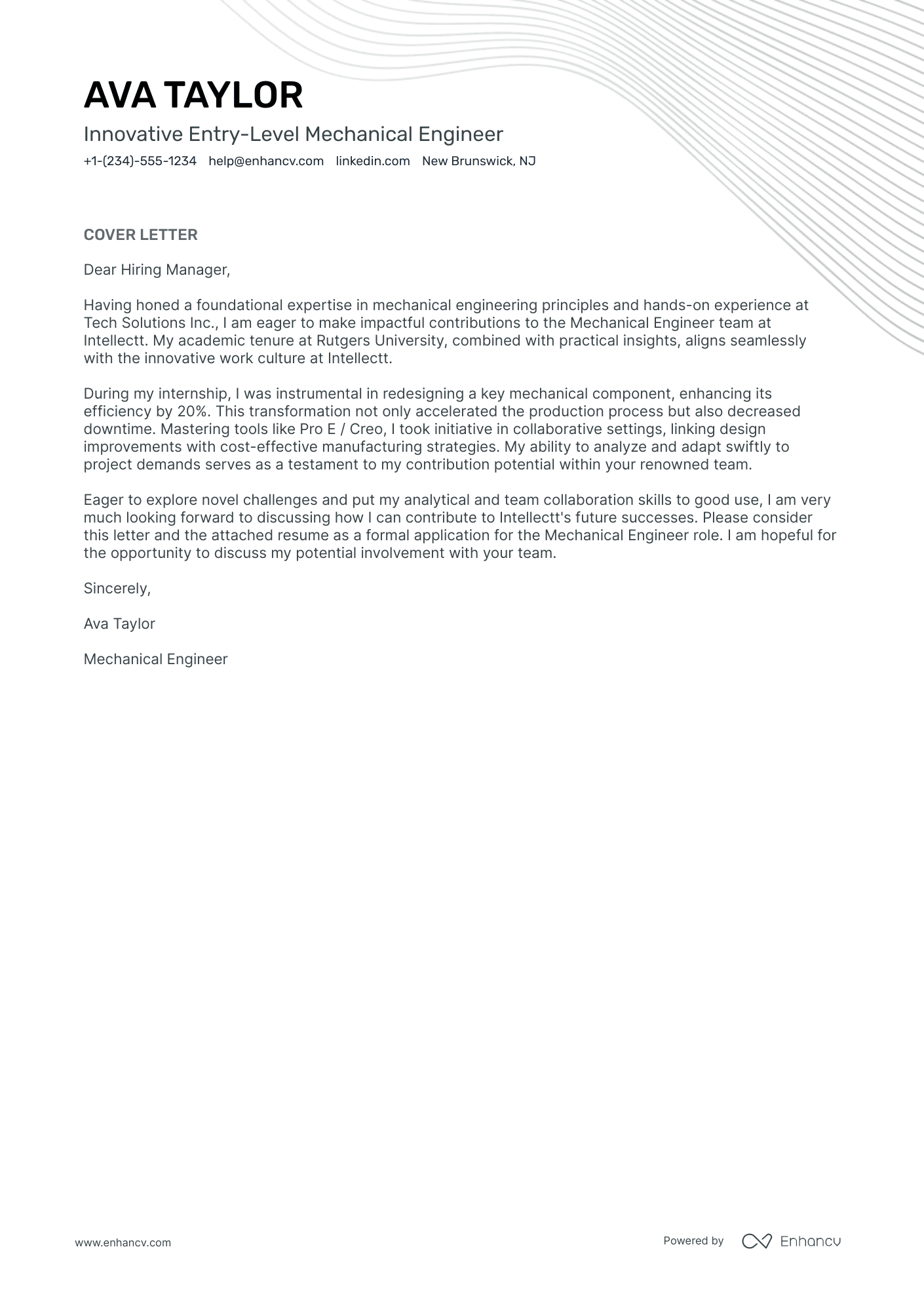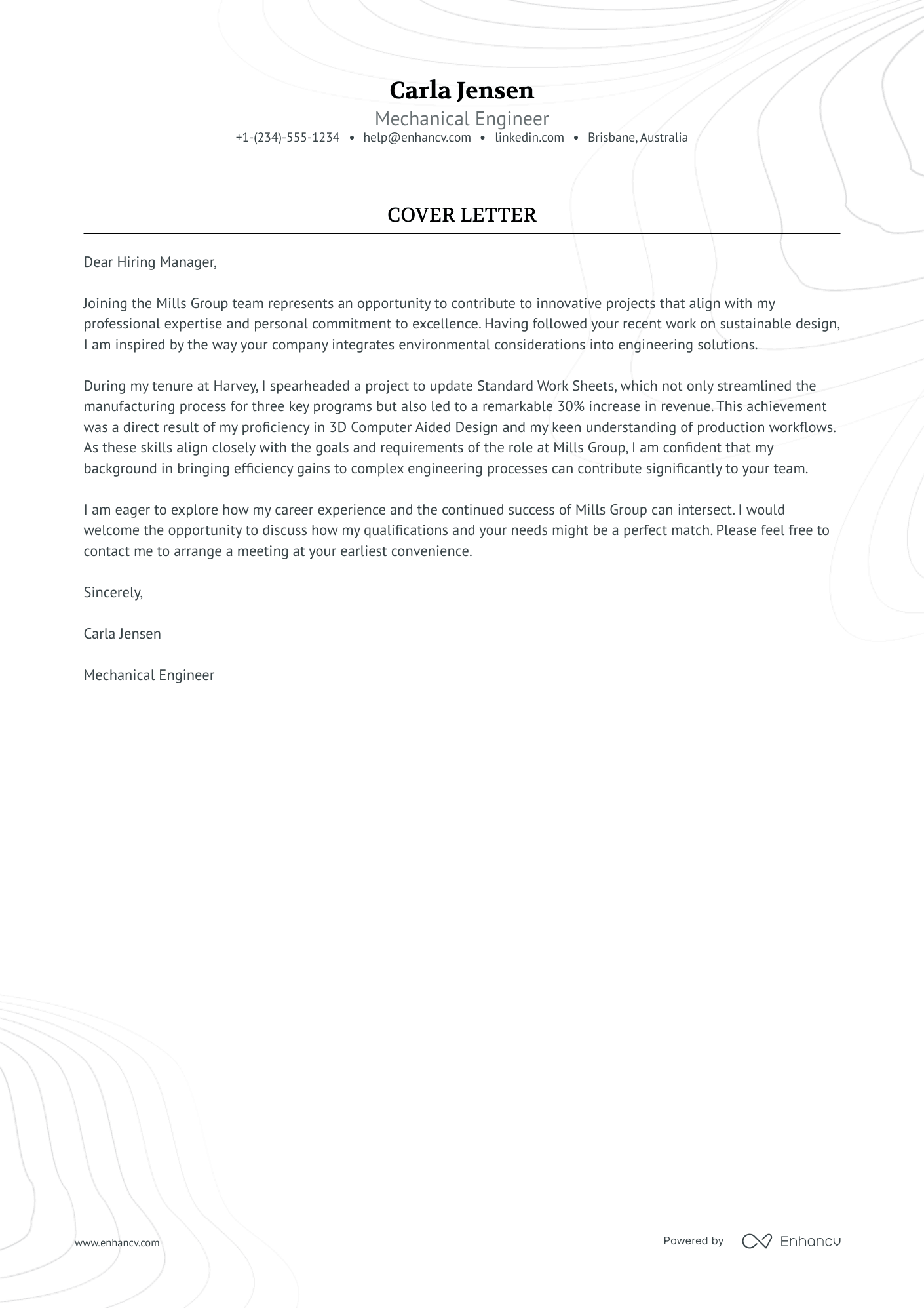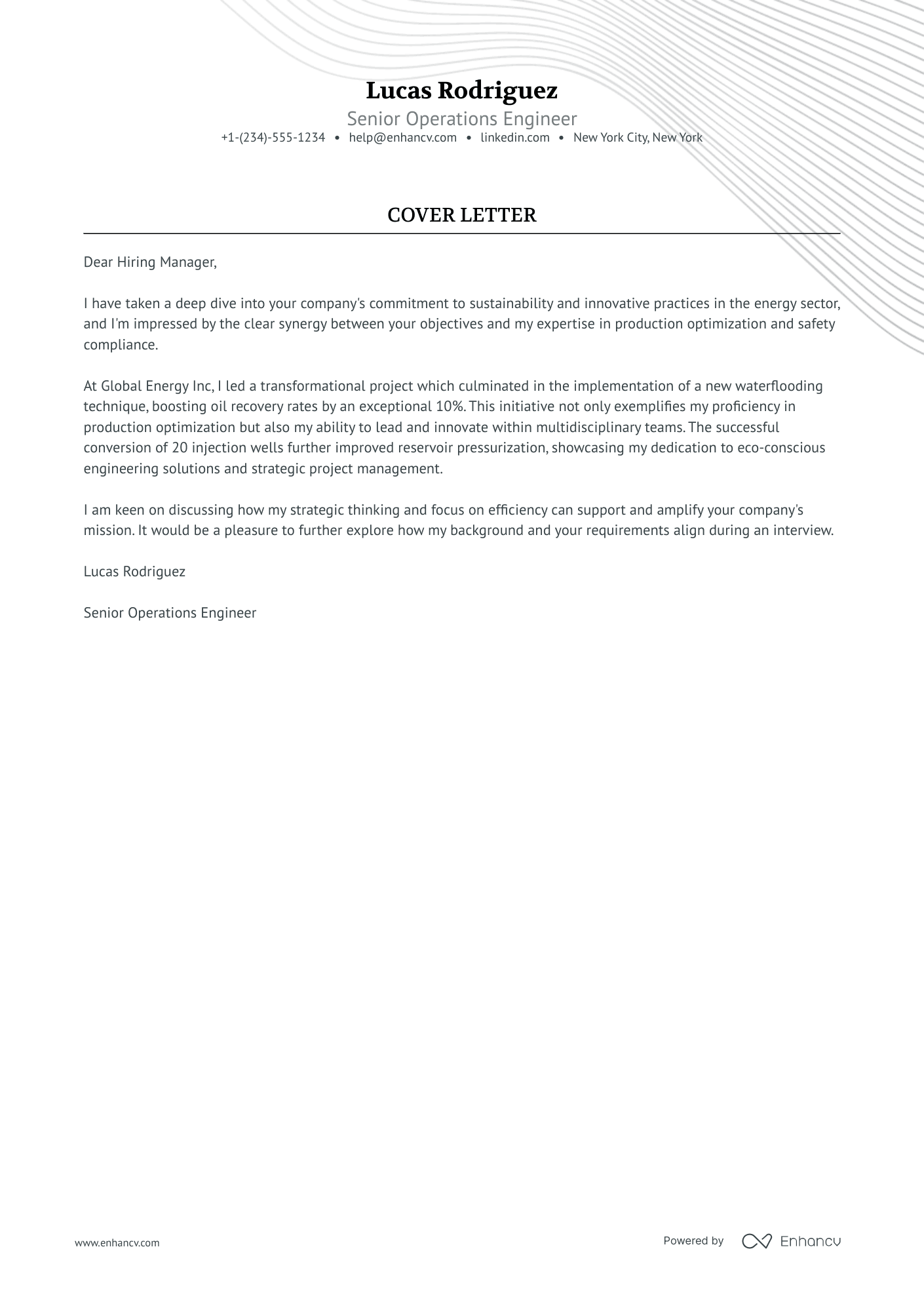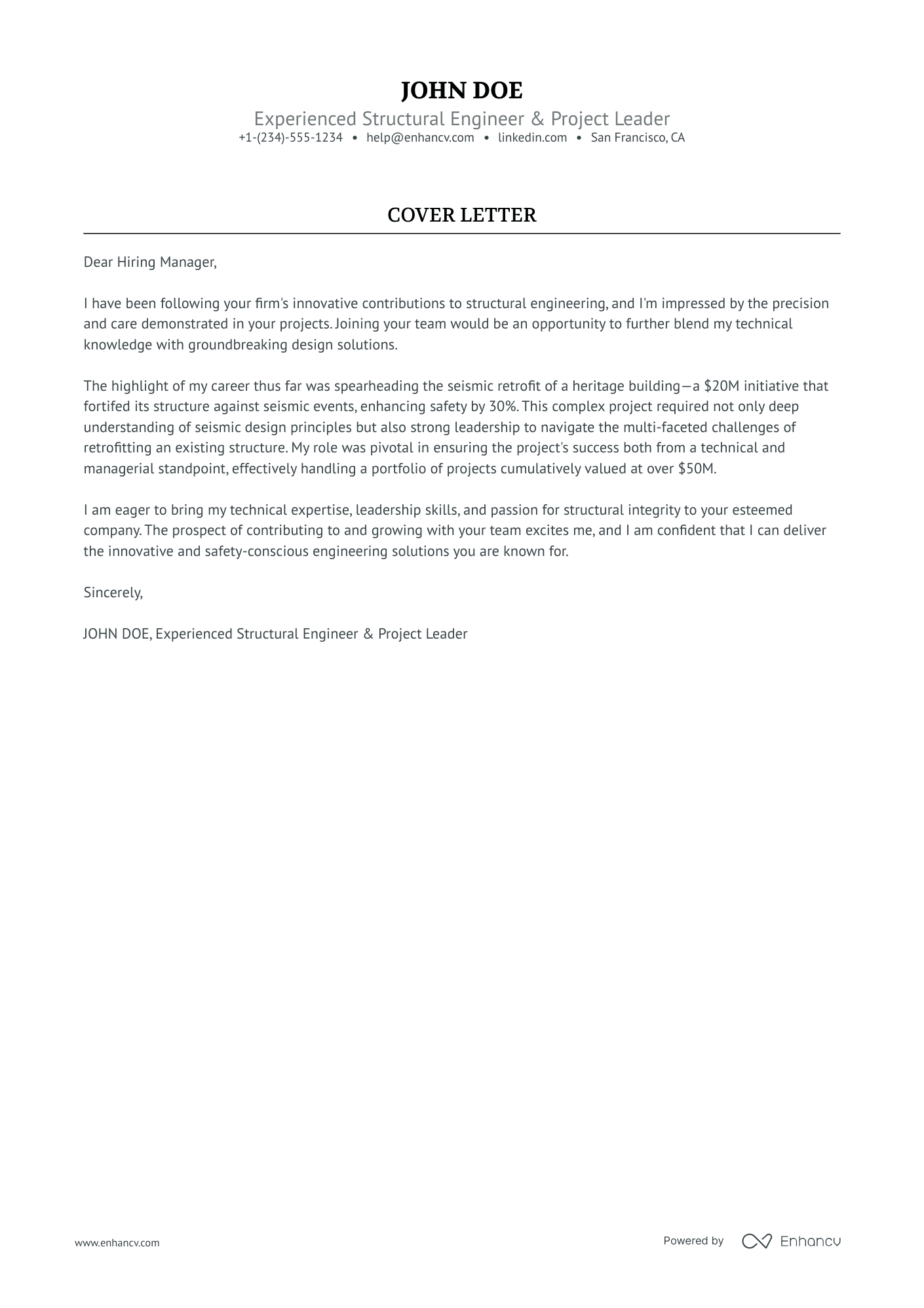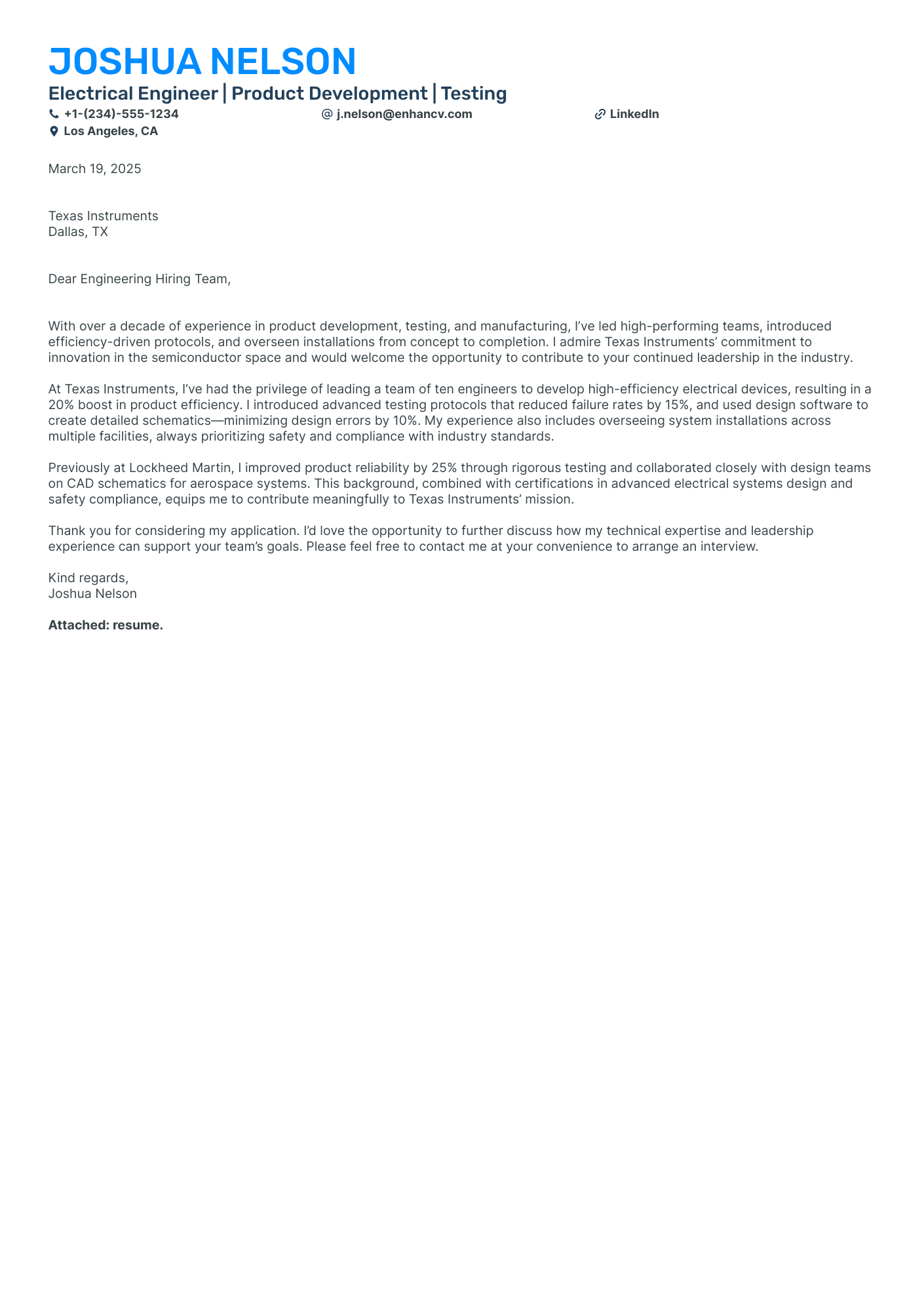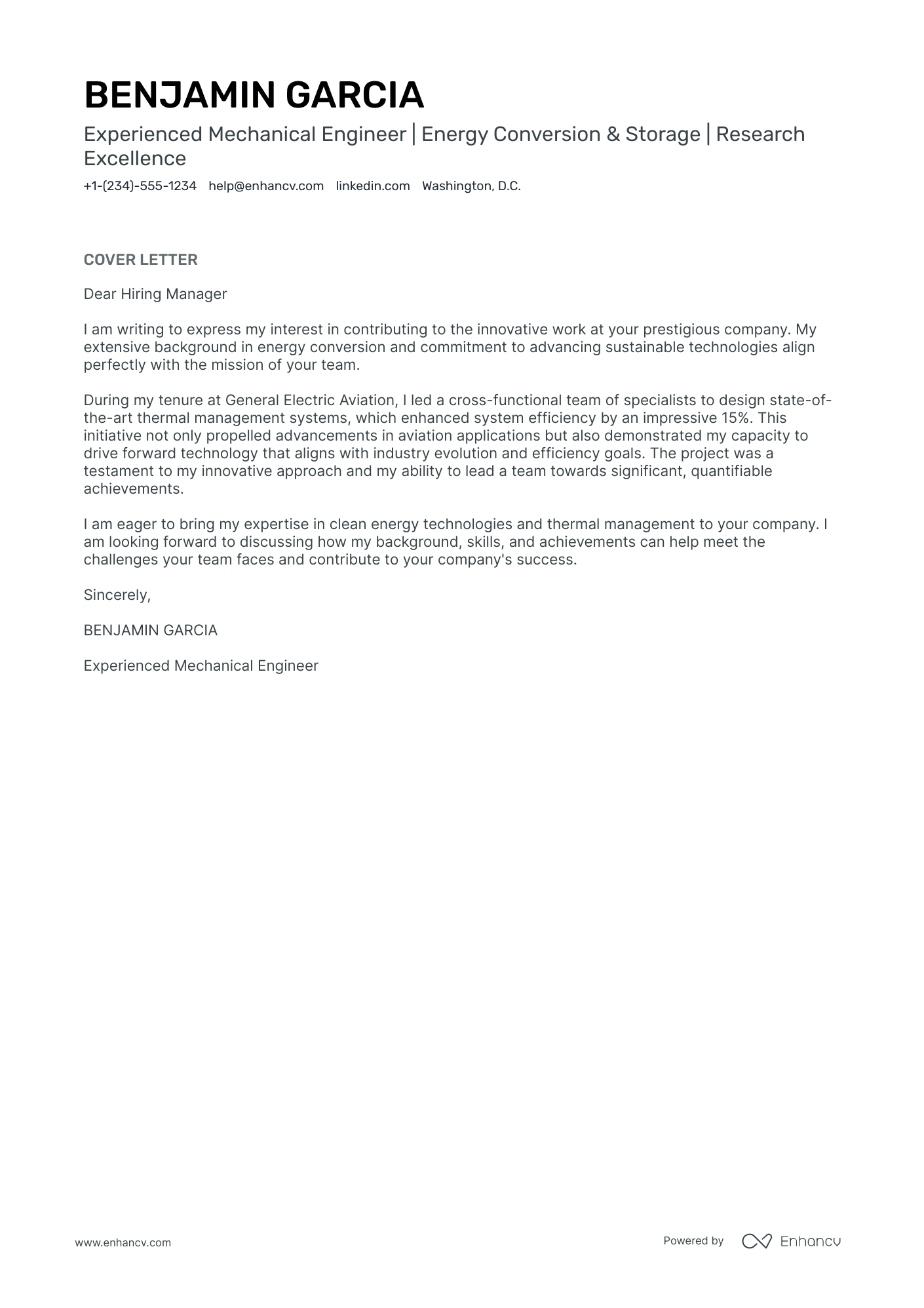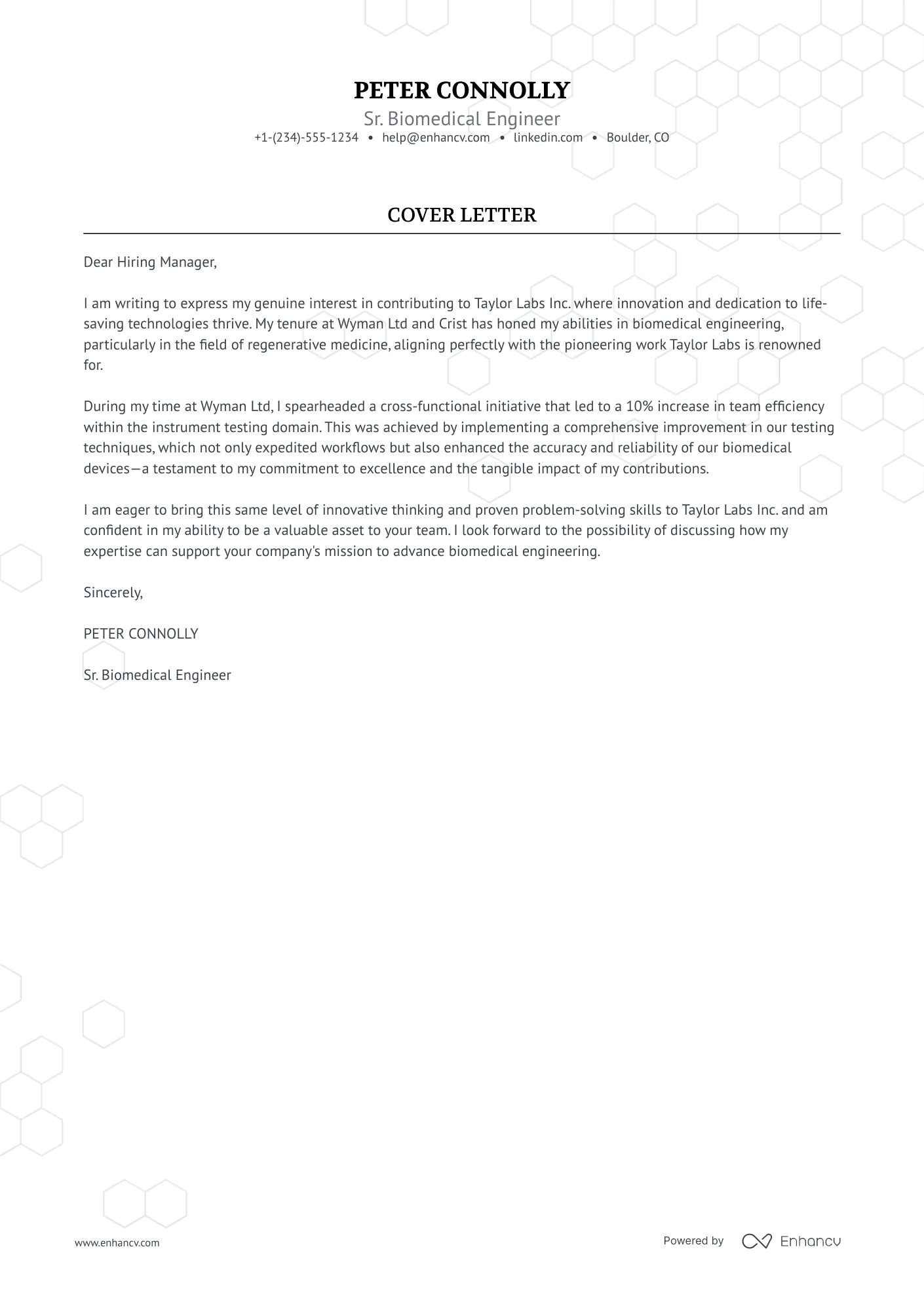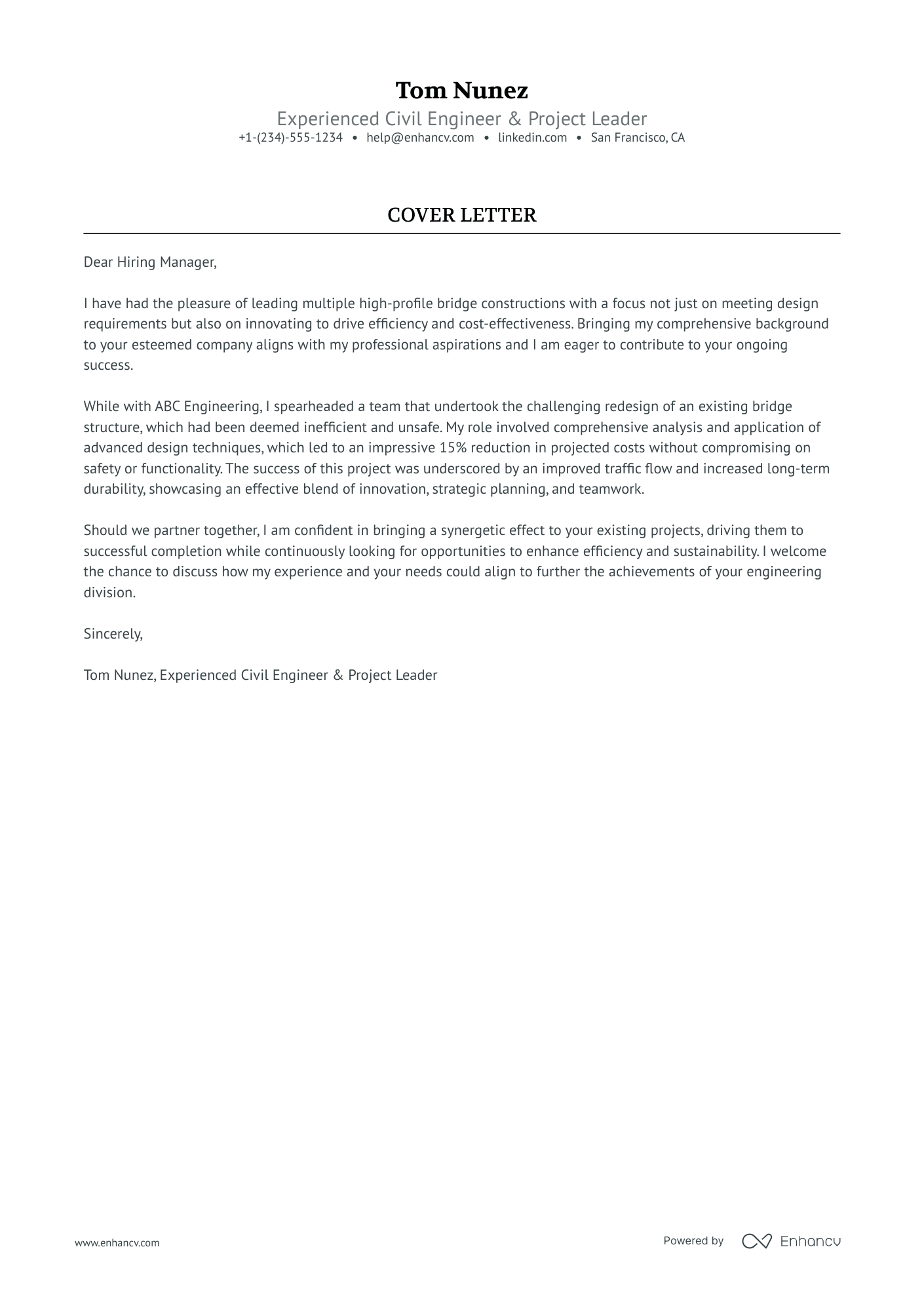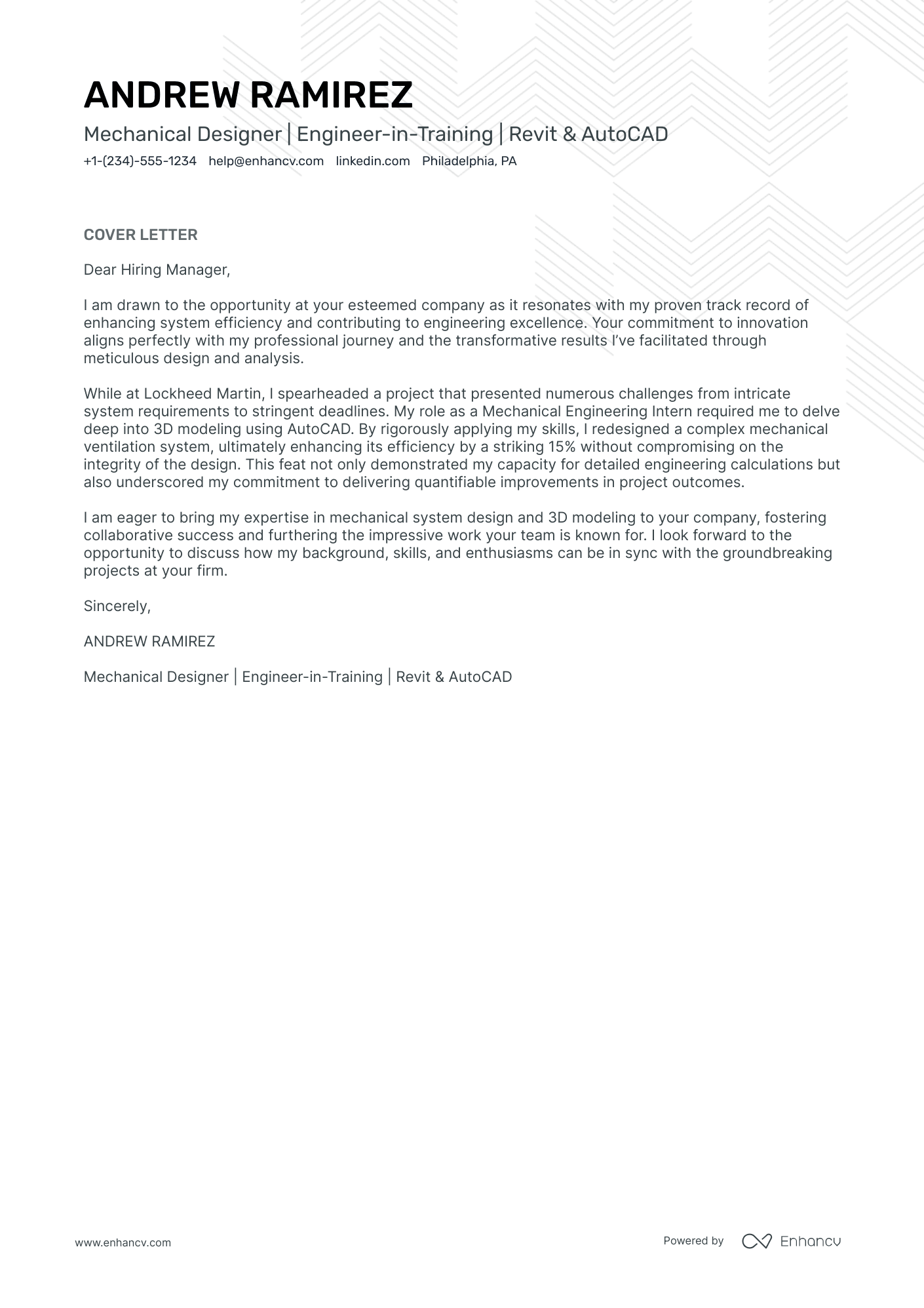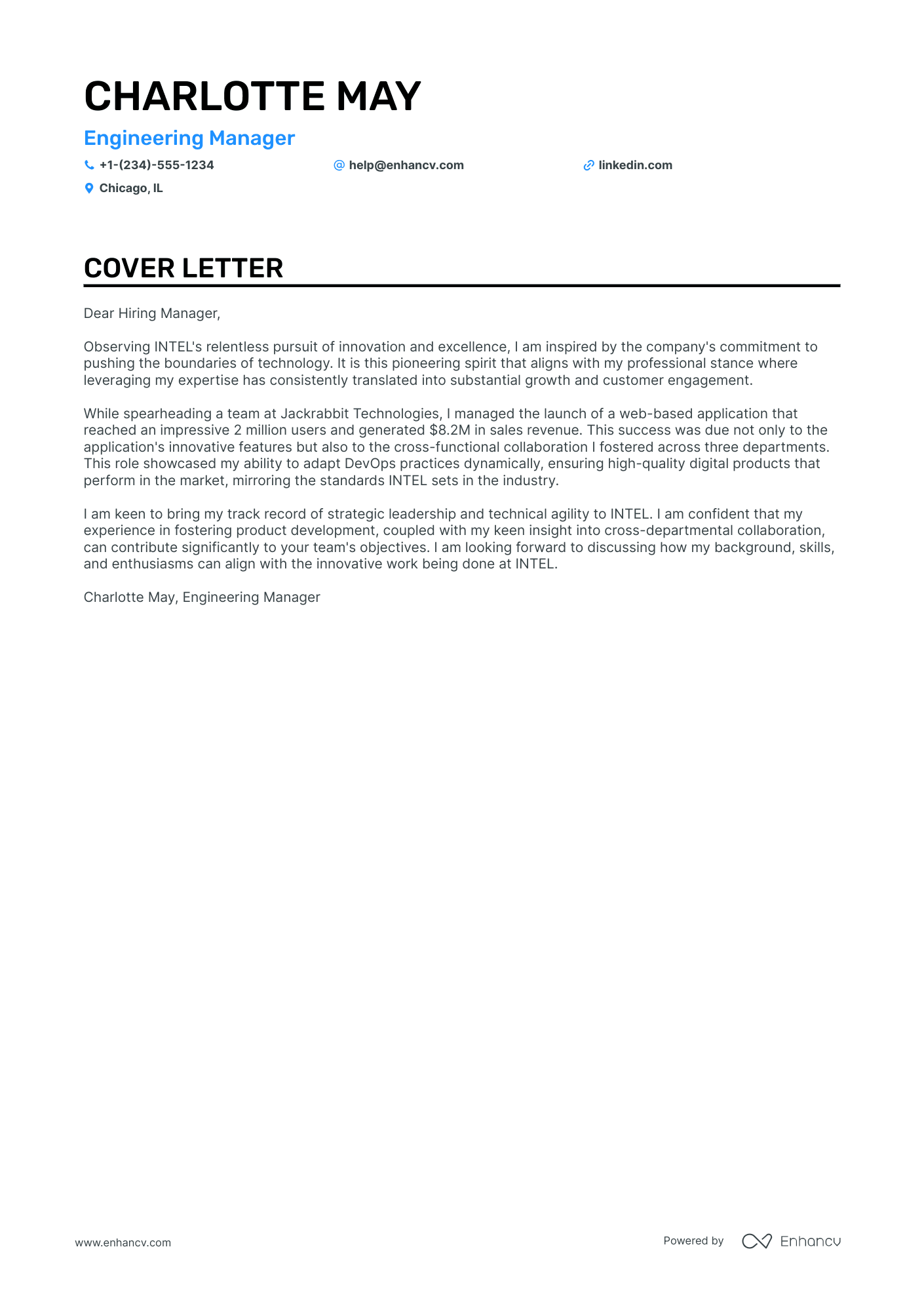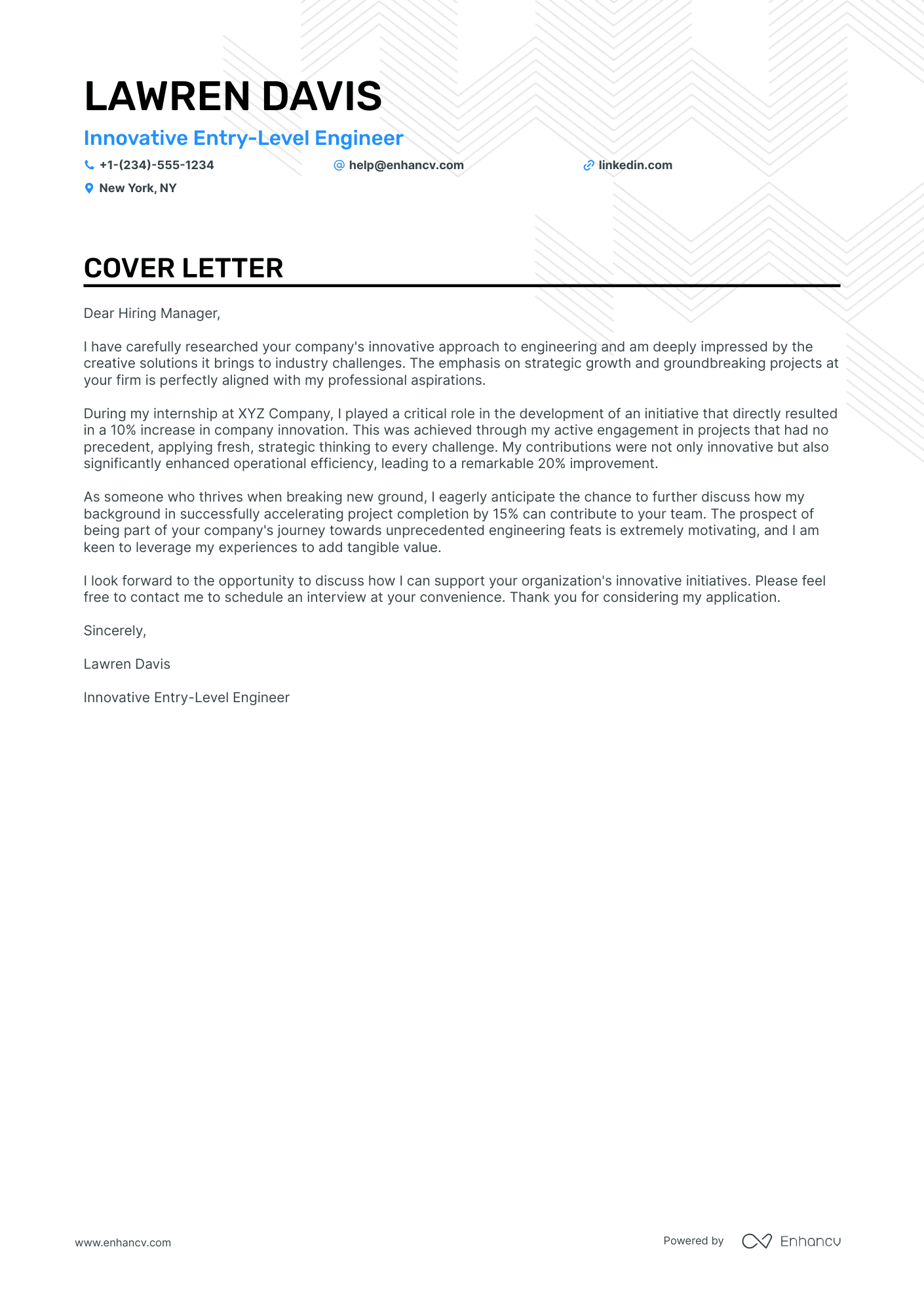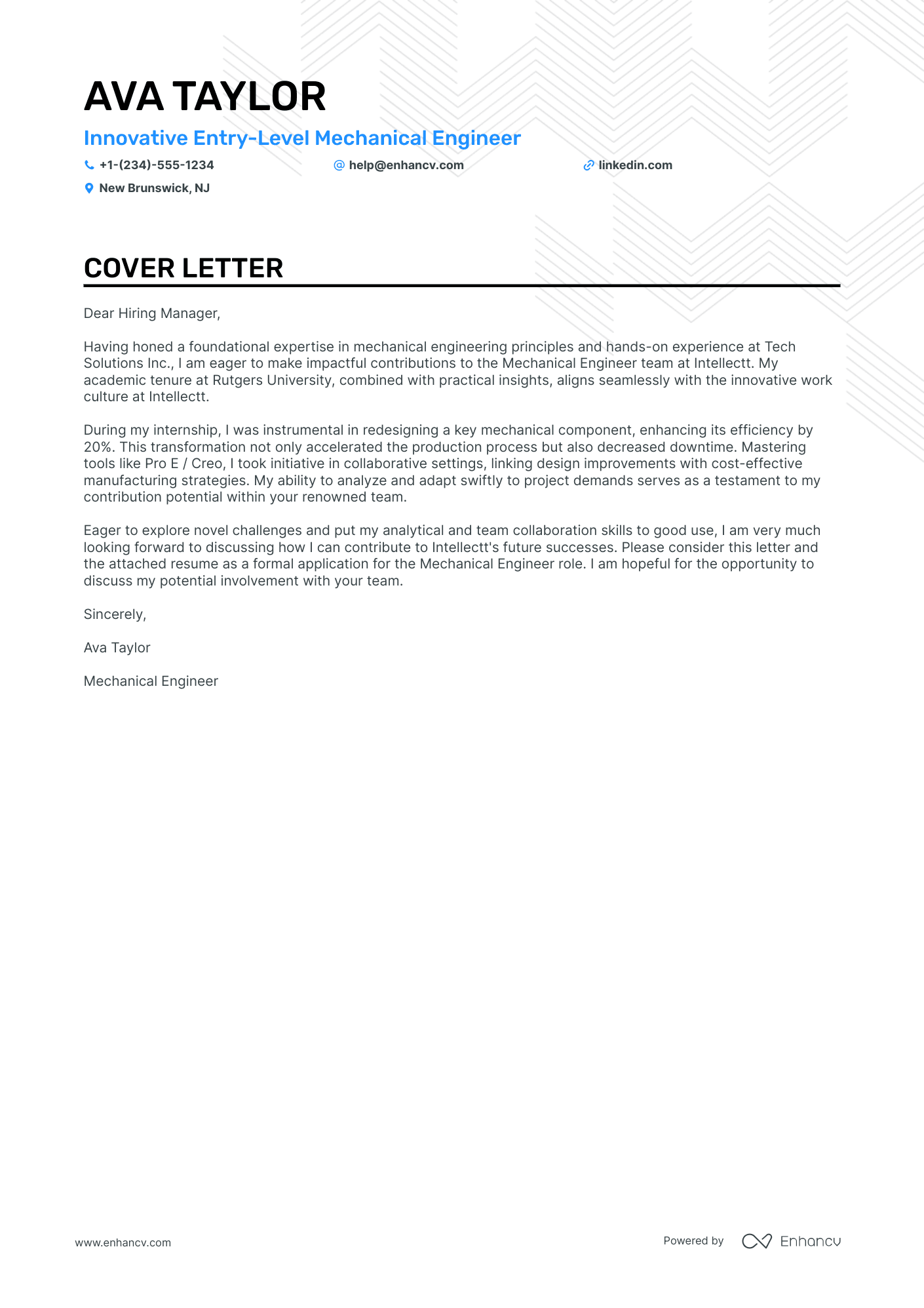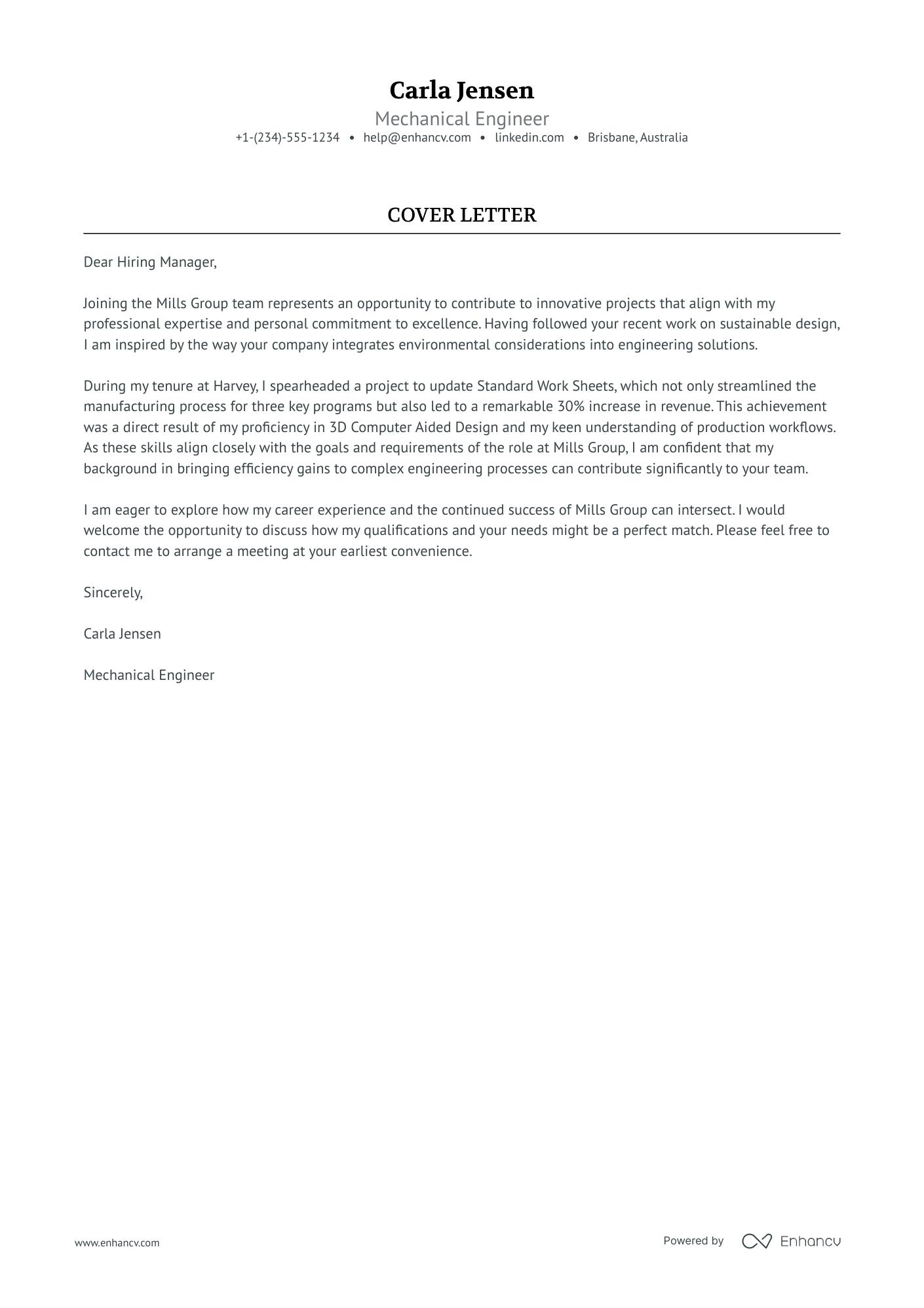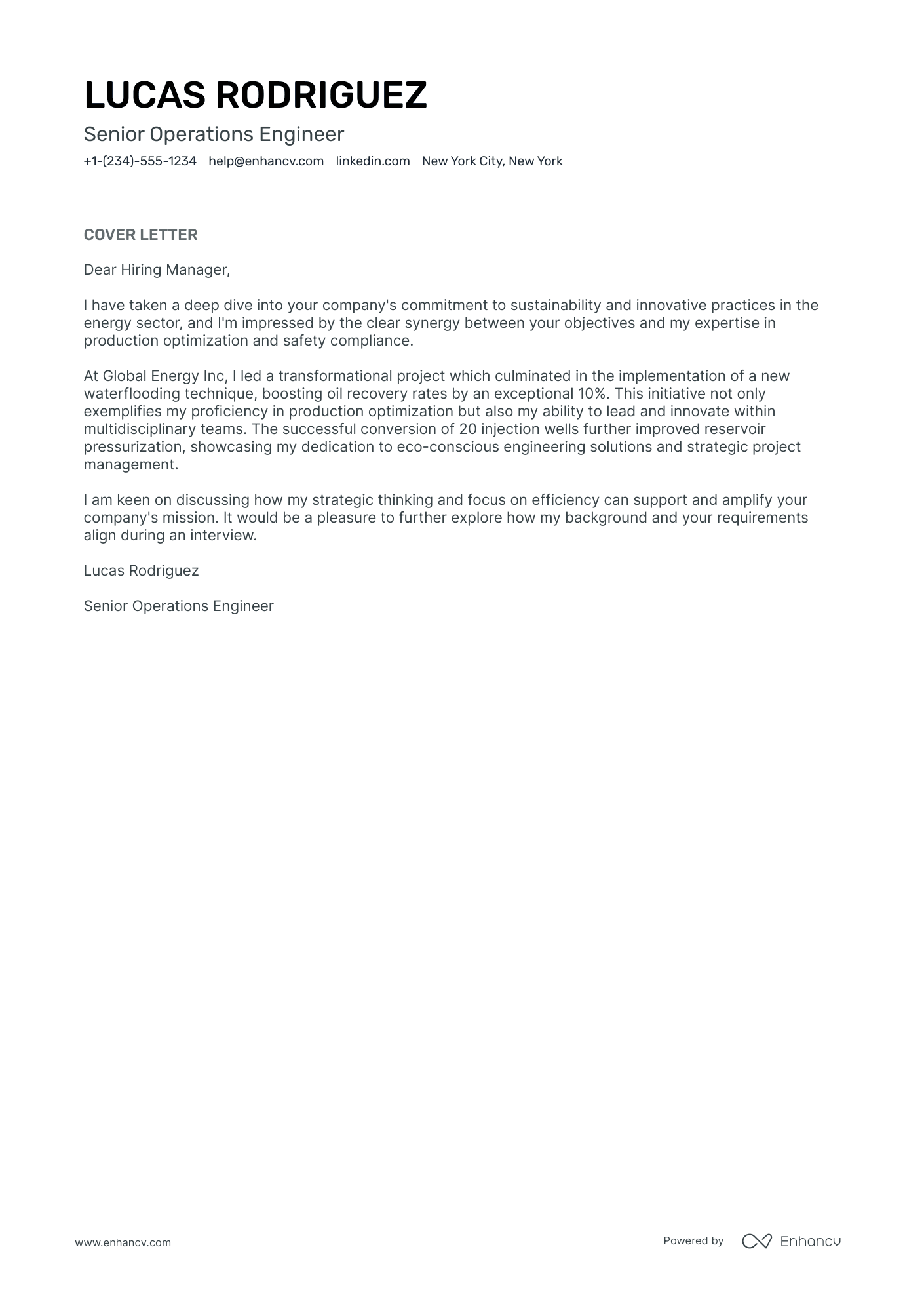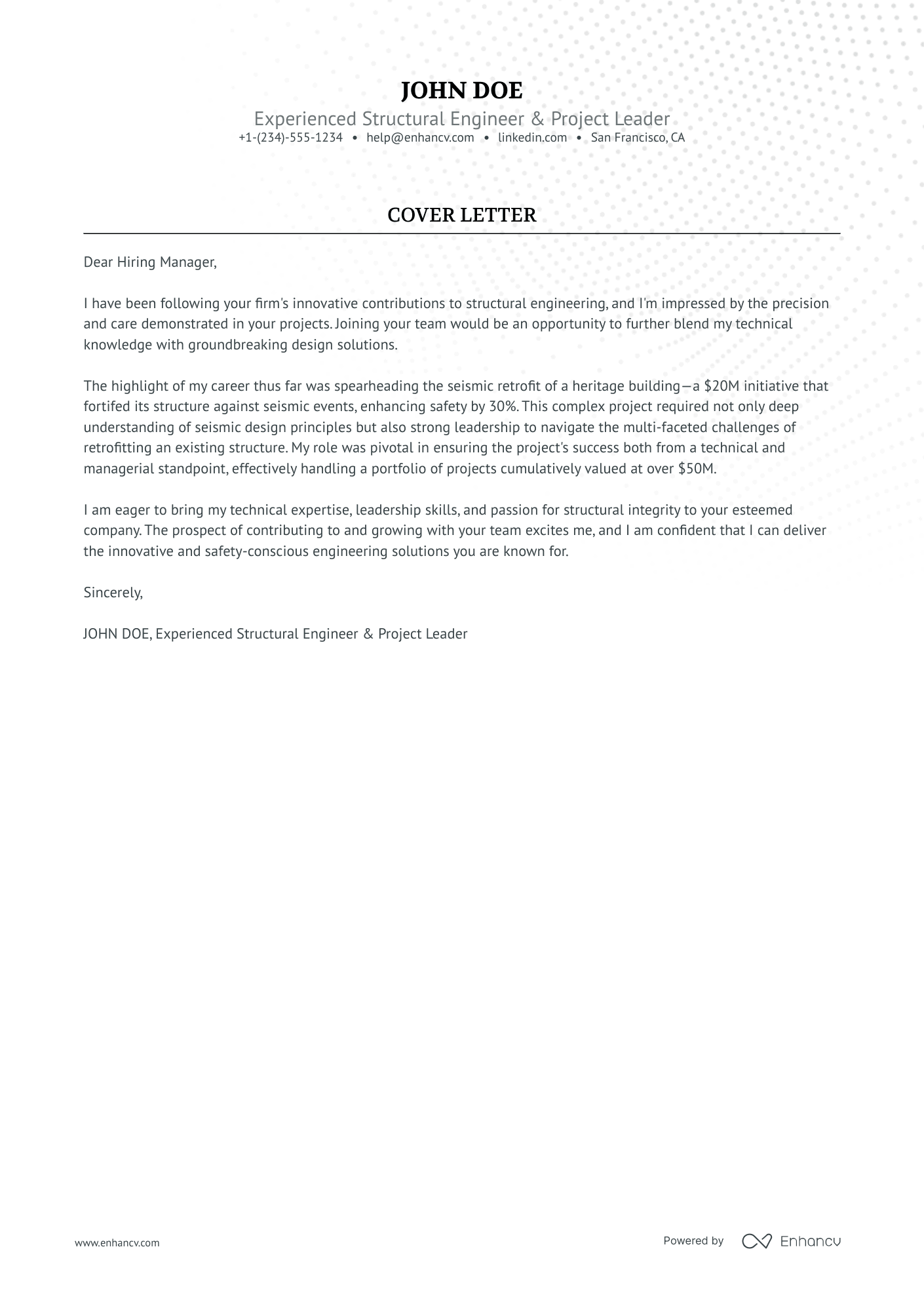Engineering is all about precision, data, and solving complex problems—but how you communicate those solutions matters just as much. Whether you're applying for a civil, electrical, or mechanical engineering role, your cover letter is a chance to show you're not only technically skilled but also thoughtful, organized, and ready to collaborate.
In this guide, we’ll walk you through how to structure an engineering cover letter that’s as strong and clear as your work—complete with formatting tips, real examples, and advice tailored to your experience level.
Key takeaways
- Your cover letter should mirror the clarity and structure expected in engineering communication.
- Always tailor your greeting—personalize it when possible, or use a role-specific alternative.
- Open with an enthusiastic, targeted introduction that highlights a technical strength.
- Use the body to demonstrate problem-solving and project experience with measurable results.
- Choose a closing that’s confident and professional, and always include a clear call to action.
- Even with little experience, students and graduates can stand out by emphasizing potential and relevant academic work.
Drop your resume here or choose a file.
PDF & DOCX only. Max 2MB file size.
Engineering cover letter example
We created an engineering resume example and tailored a cover letter to it. Use the sample to create your own in minutes!
How to format an engineering cover letter
Engineering roles demand precision, technical know-how, and a problem-solving mindset. A well-formatted cover letter is your chance to show that you bring structure to everything you do—including your communication.
Let’s review the steps together.
Contact information
Your resume header includes your contact details, but your cover letter should match for consistency. A unified look signals organization and professionalism—essential traits for civil and electrical engineers.
Structure your contact info like this:
- Place your name at the top of the document for immediate recognition. If you’ve included your middle name or its initial in your resume, add it to the cover letter as well for alignment.
- Include your professional email address, phone number, and LinkedIn profile.
- Add the current date directly below your contact details.
- Follow with the recipient’s name and their title (if known), company name, and company address.
PRO TIP
If you’re a contractor, freelance engineer, or have project-based experience on your resume, linking to a personal website or online portfolio can be a major asset. It allows hiring managers to explore your completed projects, services, technical documentation, or case studies—bringing your work to life beyond the resume.
Font, spacing, and margins
Engineers are expected to communicate complex information clearly. The same should apply to your cover letter design. A clutter-free design helps your message come through without distraction.
Use these formatting tips:
- Stick to a professional, easy-to-read font, the one you used on your resume, and in the same size. That’s usually 10 pt for your main text and 12 pt for the headings.
- Use single-line spacing and standard one-inch margins to avoid clutter.
- Left-align all text for a straightforward, structured appearance.
- Keep the layout consistent with your resume.
The top sections on an engineering cover letter:
- Header: This section should include your name, contact details, and the date, establishing a professional format. This way, hiring managers can easily reach out for follow-up.
- Greeting: Addressing the letter to the specific hiring manager or engineering team demonstrates attention to detail, especially in roles like civil or electrical engineering where precision matters.
- Introduction: The opening should clearly state the role you're applying for—whether Engineer, Civil Engineer, or Electrical Engineer—and briefly highlight a key technical strength or certification relevant to that discipline.
- Body: This core section must show specific projects, design work, or problem-solving examples tailored to the role—such as infrastructure planning for civil engineers or circuit design experience for electrical engineers. This demonstrates how your background aligns with the job’s technical demands.
- Closing: Reaffirm your interest in the specific engineering position, express enthusiasm for contributing to the company's engineering objectives, and include a proactive statement about next steps.
Key qualities recruiters search for in an engineering cover letter:
- Strong analytical and problem-solving skills: Engineers are expected to dissect complex problems and develop effective, efficient solutions, making analytical thinking a cornerstone of the profession.
- Proficiency in industry-specific software and tools: Familiarity with CAD software, MATLAB, SolidWorks, or relevant simulation tools demonstrates job readiness and reduces onboarding time.
- Hands-on project or internship experience: Practical experience applying engineering principles to real-world problems shows initiative and capability beyond theoretical knowledge.
- Understanding of industry regulations and standards: Engineers must design within the parameters of safety codes, environmental regulations, and technical standards specific to their discipline.
- Collaboration in cross-functional teams: Engineering projects often involve working with manufacturing, design, and business teams. The ability to effectively communicate and collaborate is essential.
- Attention to detail and precision: Engineering work demands high accuracy, as even small mistakes can lead to system failures, safety issues, or costly revisions.
Length and format tips
Keep your engineering cover letter concise and polished with these guidelines:
- Limit the letter to 250–350 words, up to one page.
- Use short, well-organized paragraphs (three to five sentences each) for readability.
- Save the file as a PDF, same as your resume, to preserve formatting.
- Use a clear, professional filename like FirstName_LastName_Engineering_Cover_Letter.pdf.
Finally, make sure there aren’t any typos—especially for engineering roles where precision is paramount. Our cover letter generator includes an integrated spellcheck that saves you trouble.
How to write your engineering cover letter salutation
Think of your cover letter greeting as the blueprint for what follows—it sets the foundation for a thoughtful message. A professional and personalized salutation signals to the reader that you’re proactive and serious about the opportunity.
If the hiring manager’s name isn’t mentioned in the job listing, taking the initiative to find it can set your application apart. Browse the company’s website, explore LinkedIn for department leads, or even call the company to learn who handles hiring for the engineering team. Personalizing your salutation shows you're thorough—just like any good engineer should be.
If you can’t find a name, avoid stiff or outdated greetings like “To Whom It May Concern.” Instead, use a modern, role-specific alternative that keeps things professional and relevant.
Here are a few strong options for engineering applicants:
Greetings to use when you don’t know the hiring manager’s name
- Dear Engineering Hiring Team
- Dear [Company Name] Engineering Department
- Dear Civil and Electrical Engineering Recruitment Team
- Dear Hiring Manager for the Engineering Role
- Dear Technical Recruitment Team
Now that we’ve covered your salutation, let’s see how to tackle the content.
How to write your engineering cover letter intro
Engineering roles—whether in infrastructure development or power systems—are often competitive.
A well-written engineering cover letter lets you go beyond CAD drawings, technical specs, or project lists. It allows you to tell your story—highlighting your professional passion, key strengths, and how you think like an engineer. It’s where your technical skillset meets your personality and purpose.
Your introduction is your hook. It might be the only part the hiring manager reads before deciding whether to move on to your resume.
A strong engineering cover letter intro should do three key things:
- Mention the specific position you're applying for and why it excites you—referencing the company’s mission, a project they’re working on, or an industry trend you admire.
- Highlight one standout qualification—such as a design achievement, fieldwork experience, or technical specialization that’s aligned with the job.
- Set the stage for what’s ahead—hint at how your experience will bring value to the company’s engineering team.
A sample intro from a mechanical engineering cover letter
From prototyping small-scale robotics to analyzing HVAC systems for energy efficiency, I’ve always been drawn to solving real-world problems through mechanical design. After completing a mechanical systems internship at Jacobs, I gained hands-on experience with SolidWorks, FEA, and thermal modeling. I’m particularly excited about the opportunity to contribute to Tesla’s mechanical engineering team, especially in optimizing thermal performance for high-efficiency systems. My technical training and hands-on design background position me to add value from day one.
Here are the strong points of this intro:
- Opens with a clear, purpose-driven reason for choosing engineering.
- Highlights both fieldwork and design experience, showing a well-rounded skill set.
- References AECOM’s specific projects, proving research and alignment with their work.
How to write your engineering cover letter body
This is where you move past general interest and prove you’re equipped for the job. The body of your cover letter should connect your qualifications directly to the role by showcasing specific examples of your engineering experience and technical contributions.
Avoid simply re-listing your resume. Instead, focus on real-world results and how your skills translate to the work the company is doing—whether that’s upgrading infrastructure, modernizing energy systems, or supporting sustainable design.
What to include in your engineering cover letter body:
- Technical experience: Describe your hands-on involvement in projects and the tools or platforms you used. Mention specific technologies, systems, or software relevant to your field.
- Quantifiable impact: Highlight results—did your work reduce costs, increase efficiency, improve safety, or meet compliance goals?
- Cross-functional collaboration: Show how you worked with other teams—construction, design, regulatory, or IT—to move projects forward.
- Creative problem-solving: Engineering is about finding practical solutions. Use one example to show how you approached a challenge and what you achieved.
You can format this section using either of these approaches:
Narrative approach
This style isn’t always the most conventional choice for engineers, who often favor concise formats—but when used thoughtfully, it can be a powerful way to humanize your experience and make your application more memorable.
Opt for this approach if you want to tell a short, cohesive story about your work. It’s especially effective when you’ve contributed to standout projects and want to walk the reader through your role, the tools used, and the measurable impact you made.
A sample body from an electrical engineer cover letter
During my time as a civil engineering intern at a regional planning firm, I supported the redesign of a major storm drain network after repeated flooding events. By analyzing topographic data and running hydraulic simulations, I helped propose a new layout that increased drainage capacity by 30%. The project was approved for funding and is now part of the city’s resilience strategy.
Later, in an electrical engineering co-op at a utility provider, I assisted with substation automation upgrades. I helped implement PLC programming for relay coordination and supported compliance documentation under NERC standards. These upgrades contributed to a 15% reduction in outage response time across the district.
Bulleted highlights approach
This approach is ideal if you want to make your qualifications immediately scannable—especially helpful for technical hiring managers in engineering. Use three to five bullet points to present your most relevant accomplishments. It’s a strong option if you’ve worked across multiple projects or want to highlight a broad skill set.
Remember, don’t repeat what you already mentioned on your resume.
A sample body from an electric engineer cover letter
- Supported the design and installation of a 500kW rooftop solar PV system, using PVsyst for performance modeling and contributing to a 20% increase in site energy efficiency.
- Performed short-circuit, arc flash, and load flow studies in ETAP for a manufacturing facility, ensuring compliance with IEEE and NEC standards.
- Programmed and tested PLCs for automated conveyor systems in a distribution center, reducing downtime by 18% through optimized sequencing.
- Created detailed electrical single-line diagrams and panel schedules in AutoCAD Electrical, improving cross-team coordination during construction.
- Assisted with the commissioning of a medium-voltage substation upgrade, verifying relay settings and SCADA integration for improved reliability.
This example works because it highlights core electrical engineering competencies—like power system analysis, PLC programming, and renewable energy design—while referencing industry-standard tools.
How do I write an engineering student cover letter?
When you don’t have much experience, it’s easy to wonder how you’ll fill an entire resume—let alone a resume and a cover letter. But even as a student or recent graduate, you have more to offer than you might think.
Focus on your academic background, hands-on class projects, technical skills, and your enthusiasm to apply what you’ve learned. Whether you're writing a cover letter for an engineering internship or a cover letter as an engineering graduate, highlight relevant software tools, show how you’ve solved problems in team settings, and connect your interests to the company’s work.
With the right structure and mindset, your cover letter can position you as a capable, motivated candidate—ready to grow into the role.
How to write the closing paragraph
Your closing paragraph is your final opportunity to reinforce your enthusiasm, align your skills with the company’s goals, and guide the hiring manager toward the next step.
A strong engineering cover letter closing should leave a lasting impression by:
- Reiterating your excitement for the position and company.
- Summarizing how your background aligns with the role.
- Including a polite and confident call to action.
- Thanking the reader for their time and consideration.
A sample closing from an engineer cover letter
Thank you for considering my application for the engineering role at Siemens. I’m genuinely excited about the opportunity to join a company known for driving innovation across energy, infrastructure, and automation. I’d love the chance to bring my technical skills, collaborative approach, and curiosity to your team.
Please feel free to contact me if you'd like to discuss how I can contribute to your ongoing projects—I’d be glad to connect.
Sign-off options for engineering cover letters
Your sign-off is more than just a formality—it’s the final tone you leave with the reader. Choose one that matches the voice of your letter and the level of formality in the role or industry.
| Sign-off | What’s the tone and when to use |
|---|---|
| Best regards | Tone: Professional, neutral
|
| Kind regards | Tone: Professional, slightly warm
|
| Sincerely | Tone: Formal, traditional
|
| With appreciation | Tone: Grateful, polite
|
| Respectfully | Tone: Very formal
|
Add your name and surname directly after your sign-off. Additionally, you could mention you’ve attached a portfolio or your resume.
Attachment
Best regards,
Jordan Patel
Enclosure: resume and portfolio
Conclusion
An engineering cover letter should reflect the same precision and clarity you bring to your technical work. With the right format, tone, and tailored content, you'll show employers you’re not just qualified—but ready to contribute.
Engineering cover letter examples
By Experience
Engineering Intern
By Role
